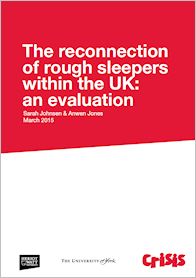Is reconnection working for Britain's rough sleepers?
Posted on 10 April 2015
A new report looking at the evidence behind the practice of reconnecting rough sleepers with their home area has been released by Crisis. It was researched and written by Professor Sarah Johnsen and Dr Anwen Jones from CHP. It aimed to:

- document the rationale underpinning the utilisation of reconnection
- examine the ways it is articulated ‘on the ground’
- assess its impact on rough sleepers.
‘Reconnection’, is defined in policy terms as “the process by which people sleeping rough, who have a connection to another area where they can access accommodation and/or social, family and support networks, are supported to return to this area in a planned way” (Homeless Link, 2014b, p.3). It is being used more frequently by authorities in England in recent years but there was little evidence on its impact on rough sleepers.
Key findings from the study include:
- national guidance outlining agreed good practice exists, but implementation often deviates from this quite substantially
- outcomes are only recorded in a small minority of cases. The limited data available suggest that reconnection experiences and outcomes vary dramatically
- practitioners generally agree that reconnection is wholly appropriate and potentially beneficial in some circumstances
- recognised ethical dilemmas arise when rough sleepers who refues to comply are denied access to homelessness services in the new area
- tightening of 'local connection' criteria leave rough sleepers with no evidence of connection to a locality.
The Head of Research at Crisis has written a blog about the findings from the reconnection study.
The full report, which includes an executive summary, can be downloaded here: Reconnection of Rough Sleepers within the UK (PDF ![]() , 793kb)
, 793kb)
